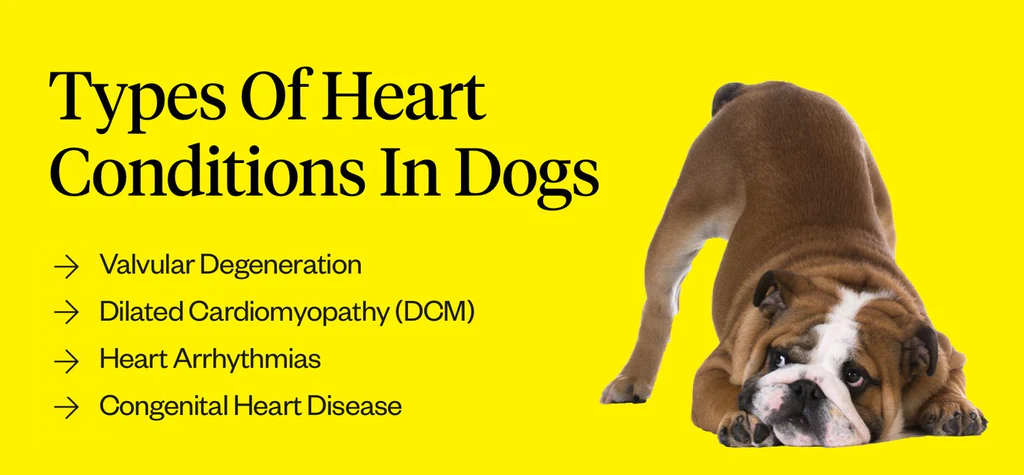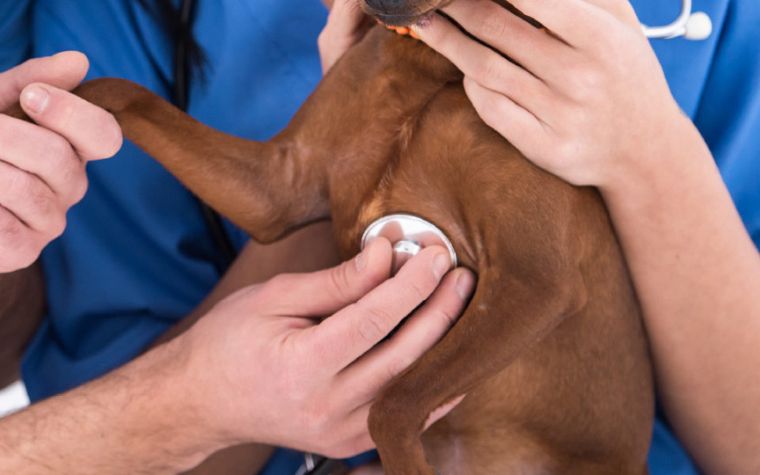Our dog’s heart is the organ that produces an abundance of love, kindness, and loyalty. But do you know that even a dog’s heart can be a source of concern? Yeah, even dogs are susceptible to heart disease. This article will tell you more about different types of heart diseases, the symptoms of congenital heart diseases, and how to minimize congenital heart disease in dogs.
The term heart disease means any condition that affects your dog’s heart or blood vessels and disturbs their normal functions. If your pooch exhibits any signs or symptoms of heart disease, then it is important to take them to their vet for a more specific diagnosis and treatment plan.
The heart is an important and complex organ for all living beings, and heart diseases in dogs can show up in a variety of ways affecting specific parts of the heart and body.
Also Read:- Protect your Dog from Getting Sick Dog Health Issues
Types Of Congenital Heart Disease In Dogs

Heart disease in dogs can be either congenital or acquired,
# Congenital Conditions
Congenital conditions are heart disease that has been present since the birth of your pup. It may be due to the breed’s predisposition or a condition that has been passed down from their parents. Following are some of the common types of congenital heart issues in dogs.
1. Congestive Heart Failure
It happens if your dog’s heart is unable to pump the proper amount of blood to the entire body. It causes increased fluid levels and pressure within the heart, which may leak into the lungs causing breathing problems for him and, It may affect both sides of the heart and takes years to get noticed.
2. Canine Dilated Cardiomyopathy
It affects the cardiac muscles and
reduces the heart’s ability to
produce enough pressure
to pump blood throughout the
vascular system. This can be
genetic or can be caused
by factors related to nutrition or
infections.
3. Pulmonic Stenosis
This will obstruct the blood flow from the right ventricle to the pulmonary artery. It can also affect the blood flow between the heart and the lungs.
4. Patent Ductus Arteriousus
The ductus arteriosus is a short, broad vessel in the unborn fetus that connects the pulmonary artery with the aorta and allows most of the blood to flow directly from the right ventricle to the aorta.
Before birth, oxygenated blood within the main pulmonary artery passes into the descending aorta through this ductus arteriosus, bypassing the nonfunctional lungs.
After birth, inflation of the lungs during the puppy’s first breath causes the ductus to close and allows the blood to flow to the lungs.
If the ductus won’t close, then the blood flow is forced from the left chambers of the heart to the right chambers, which are called left-to-right shunts.
They result in over-circulation of the lungs and enlargement of the left heart chambers and cause arrhythmias due to which signs of left-sided congestive heart failure will develop over some time.
If the dogs have small ductus, they may reach adulthood without any signs of heart failure, but most affected dogs will retain extra fluid even after they grow.
A large patent ductus arteriosus will result in high blood pressure in the arteries of the lungs, causing a heavy workload on the heart. When severe, shunting may become slow and reverse( from right to left).
You can notice a continuous, machinery-like murmur in dogs with PDA with left-to-right shunting. You can feel this vibration when you touch the puppy’s ribcage over the area at the base of the heart.
In some puppies, the ductus remains open for a few days after birth. Most young pooches don’t show any signs, but those with a larger shunt and older dogs will have the signs of left-sided congestive heart failure and Arrhythmias can be heard.
Large abnormalities may show up on x-ray and echocardiography will help in excluding coexisting heart diseases present at birth, as well as showing if the PDA is present.
Surgery can help to close the ductus with left-to-right shunting PDA and is the best treatment option. Drugs can be needed to treat congestive heart failure before surgery.
Surgery may include tying off the ductus and blocking the ductus from the inside. The vet will suggest the proper surgical option based on the size of the ductus and the size of your pup.
Dogs with a PDA right-to-left will exhibit fatigue, exercise intolerance, and collapse. Careful examination may reveal a sight bluish tinge to skin and membranes in the back half of the dog.
There may be some other abnormalities like a split heart sound, a soft murmur, or an abnormal increase in RBCs. ECG, X-rays, and echo will help in diagnosis.
You can’t go for surgical tying off the ductus for this as it will cause an increase in blood pressure in the arteries of the lungs and cause death. Treatment includes control of the increase in RBC through periodic blood-letting and medications to decrease the blood pressure in the lungs.
Also Read:- How to Train Your Dog? Simple Dog Training Tips and Commands
# Acquired Conditions:
These may be seen mostly in adult or middle-aged dogs. Acquired heart diseases typically develop over some time and are the results of normal wear and tear, and aging. Following are some examples of acquired conditions.
1. Canine Valvular Disease
It causes when the heart valves will become weak and begin to leak.
2. Arrhythmias
It develops within the dog’s electrical system which interferes with how it’s telling the heart to beat.
3. Pericardial Disease
It happens when the sac surrounding the heart fills with fluid and affects your dog’s heartbeat.
7 Signs Of Congenital Heart Disease In Dogs

Heart diseases in dogs are shown by many progressive diseases that take a longer time to get identified. If your pup shows any of the symptoms or behaviors listed below, then you need to consult your vet for a checkup.
- Dry cough after physical activities and that increases at night.
- Shortness of breath.
- Feeling restless during sleep.
- Instant weight loss (within a few weeks).
- Fainting
- Potbelly due to fluid buildup
- Fatigue or tiring.
Also Read:- 5 Top Secret Tricks to make Road Trip with Dogs Incredible
How To Detect Congenital Heart Disease In Dogs
It is essential to detect if there are any congenital heart issues in your pooch as early as possible. Some defects can be corrected by surgery, and treatment has to be done before it leads to congestive heart failure or irreversible heart damage.
Pets with congenital heart defects may die prematurely, causing emotional distress. Early detection will help pet parents avoid breeding dogs which help in preventing the continuation of genetic disorders in offspring.
The evaluation may include a physical examination, electrocardiography, x-rays, and echocardiography. These steps allow diagnosis and assessment of the severity of the defect.
The defects may vary depending on the type and severity of the heart disease involved.
Treatment For Congenital Heart Disease In Dogs
1. Balloon Valvuloplasty
It is a type of surgical procedure in which a catheter having a tough balloon is threaded into his heart. When the balloon is inflated, it breaks and opens the aortic or pulmonary valve
2. Catheter-Based Occlusion
In this surgery, coils or ductal occluders are placed inside two major blood vessels which helps a clot to form around them, plugging up the PDA. This cannot be preferred for smaller dog breeds.
3, Diuretics And Angiotensin-Converting Enzyme Inhibitors (ACE inhibitors
Diuretics and ACE inhibitors will help to pull fluid out of your dog’s lungs.
4. Beta-Blockers
Beta-blockers will slow your dog’s pulse and allow his heart more time to fill with blood.
5. Exercise Restriction
If your dog exhibits moderate or severe subaortic stenosis, then exercise should be restricted. Exercises cause fainting, collapse, or even sudden death.
6. Open Heart Surgery
Open heart surgery is used to treat patent ductus arteriosus. After your dog’s chest is opened, a piece of suture is used to tie off the patent ductus. Open heart surgery has a 70% survival rate.
How to Prevent Congenital Heart Disease In Dogs

Congenital heart diseases in dogs will be present from birth and you can’t prevent them. But it can be prevented by stopping dogs from breeding.
If you want to breed a dog having a high risk of heart disease, then they should have a good cardiac work-up before that.
You can treat heart disease or manage it through prescriptions, medicines and supplements, dietary adjustments, and even surgery based on the severity level.
Mildly affected dogs may not show any illness and live a normal life span. Defects causing significant circulatory disturbances will cause death in newborn and unborn puppies.
Medical or surgical treatments will benefit the dogs to moderate the severity of the problem.
Surgical correction can also be done to most affected dogs as long as no other diseases or abnormalities are present in them which may cause a risk of anesthesia or surgery.
If a genetic cause is likely or possible, then they should not be bred. This way you can control congenital heart defects in dogs.
Conclusion of Congenital Heart Disease In Dogs
Dogs are amazing friends of humans and have the sweetest heart. Their heart has to be taken utmost care of. Have you ever thought that even they will suffer from heart disease?
Yeah, even dogs can get heart diseases. Some might have congenital heart issues and others have associated heart defects.
Congenital heart disease will be present by birth. Some congenital heart diseases can be cured by simple medications and others have to be treated by surgery.
If your dog shows any symptoms of heart disease, then consult your veterinarian and get him treated for his heart disease.
You can avoid congenital heart disease from getting passed on to the offspring by stopping them from breeding.
